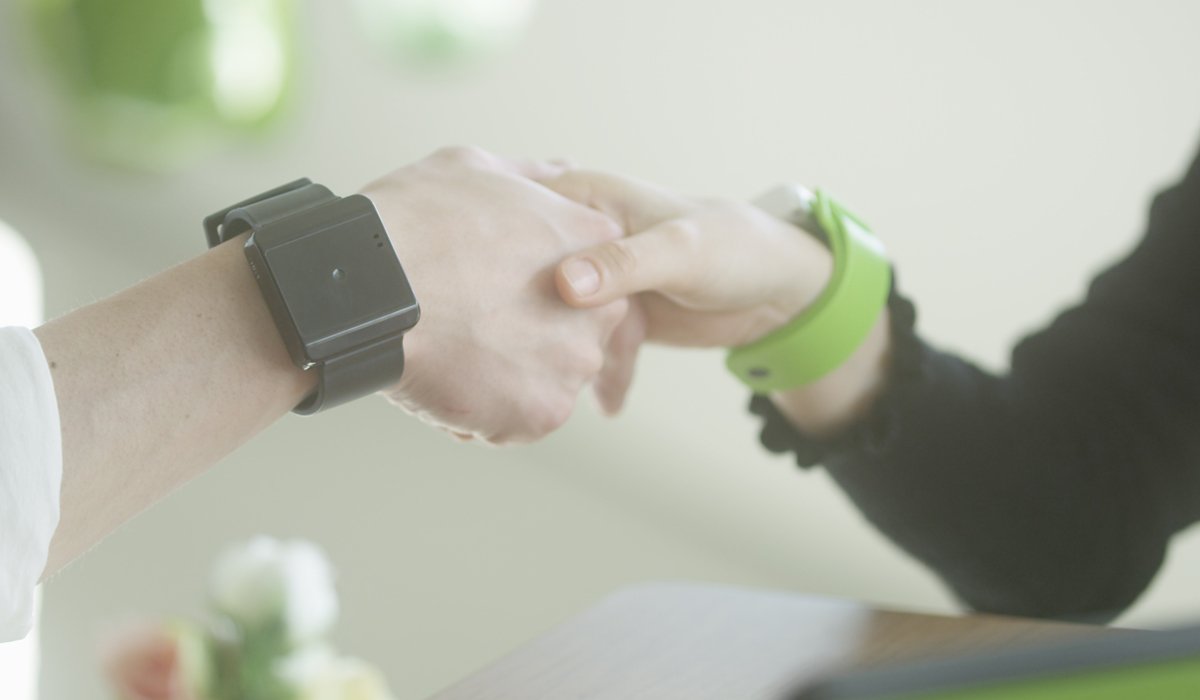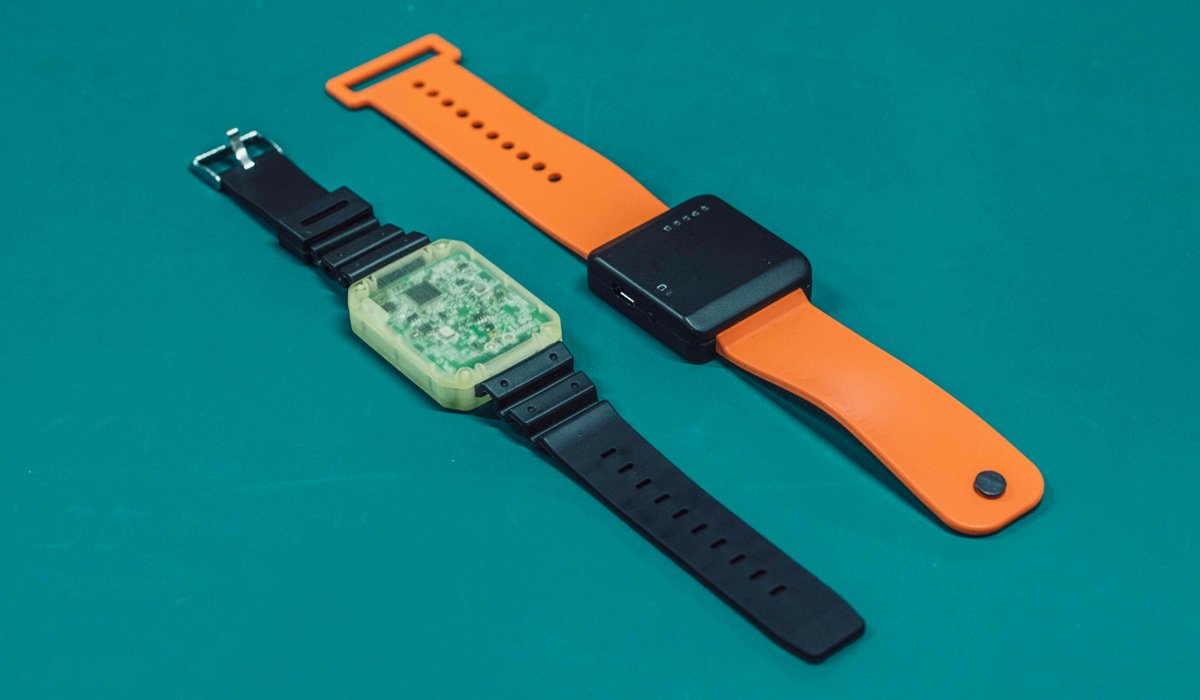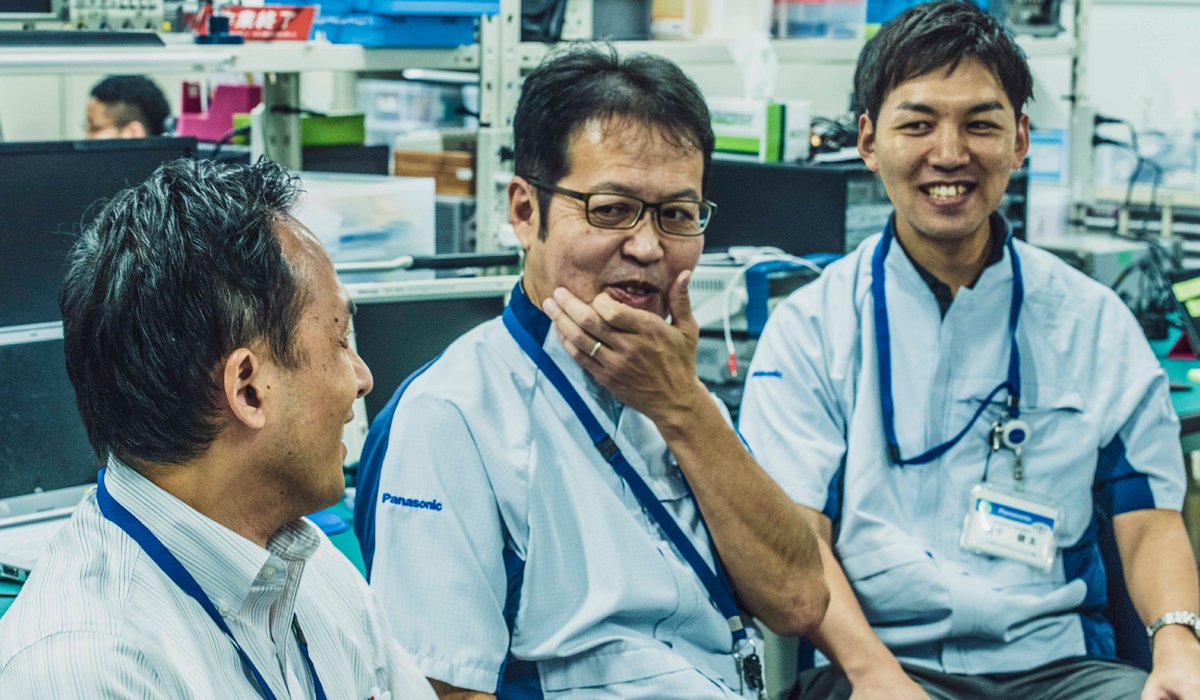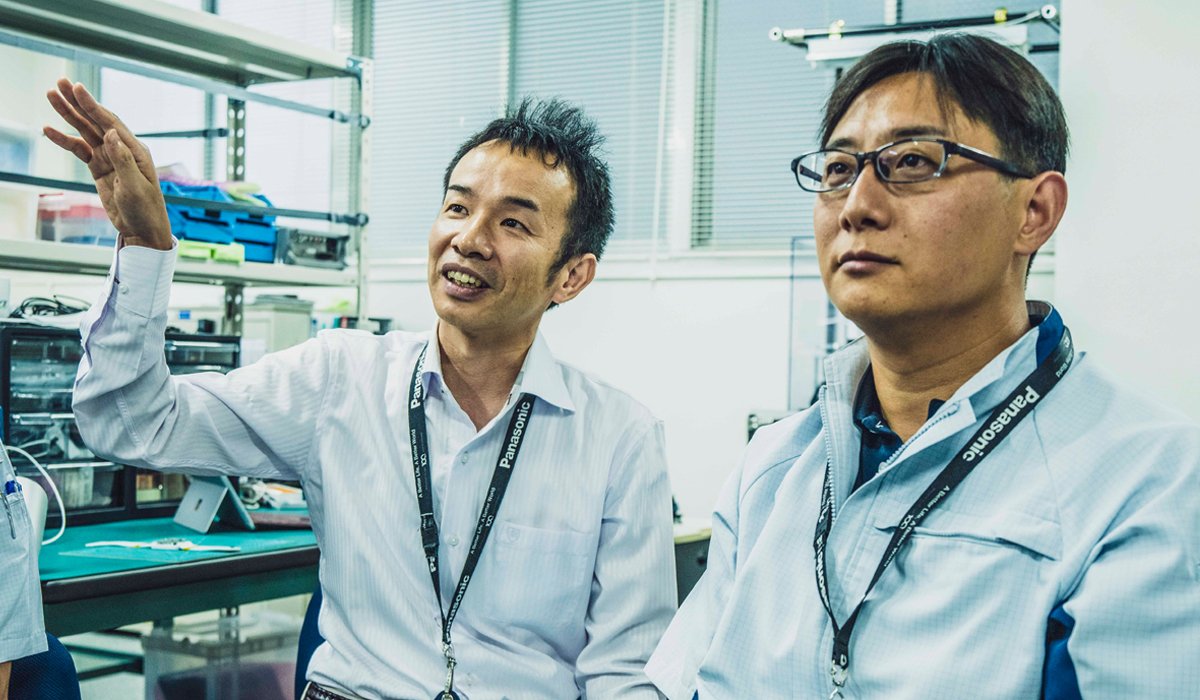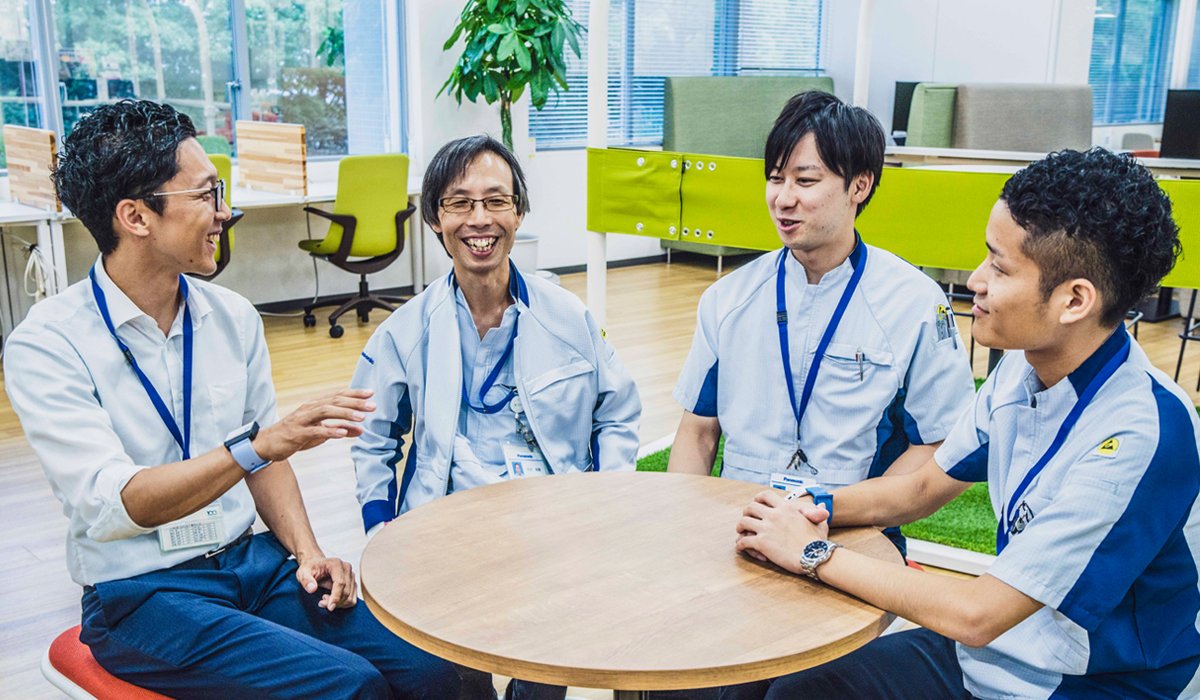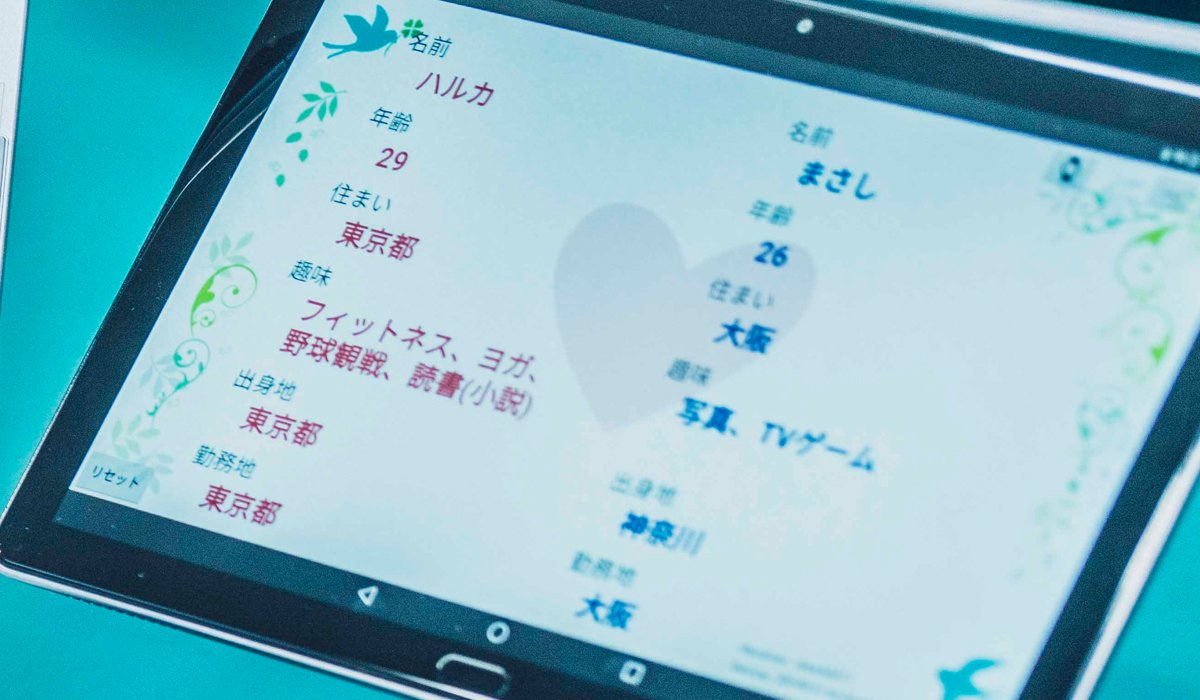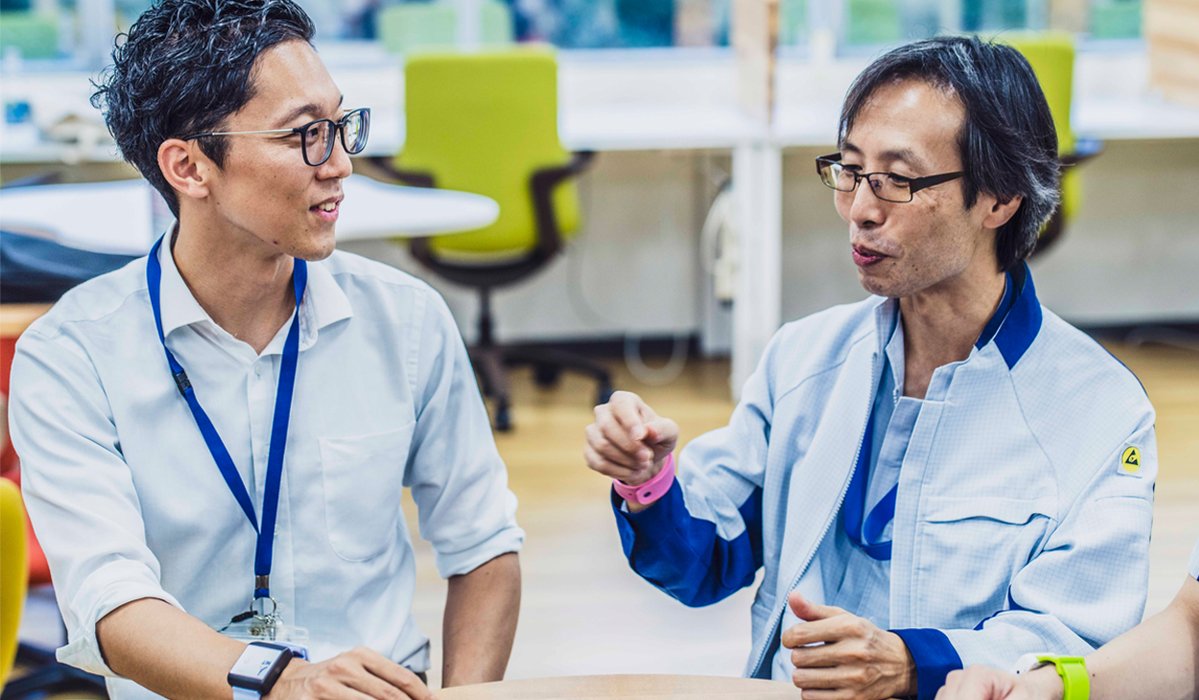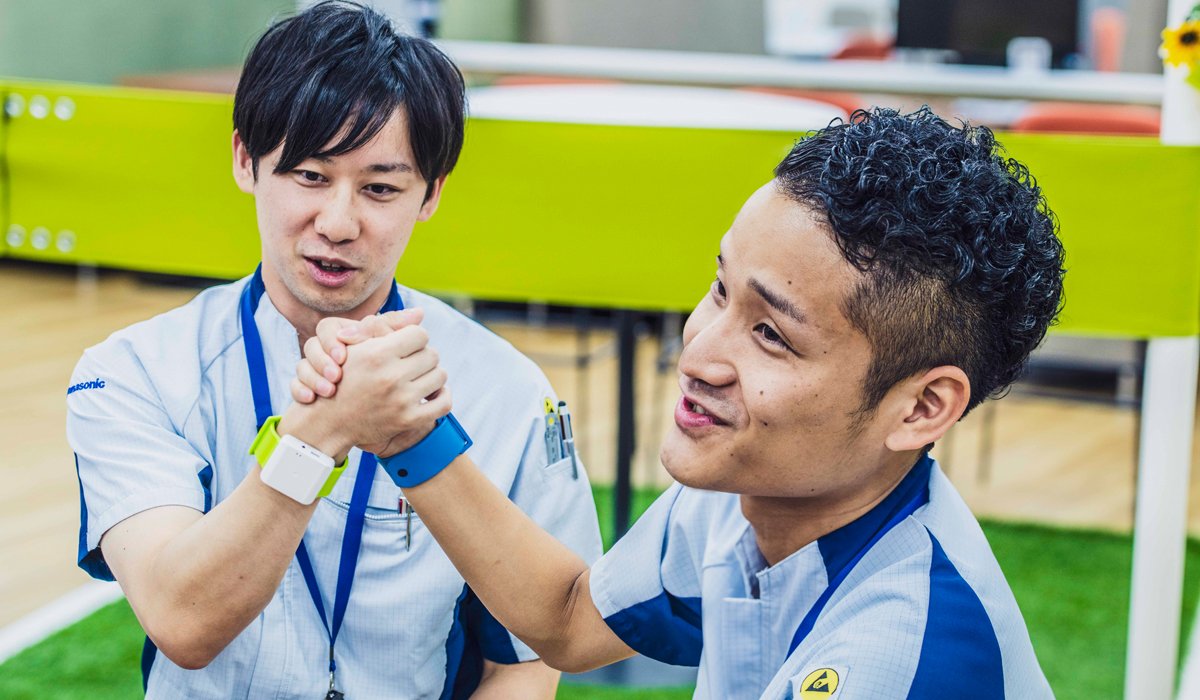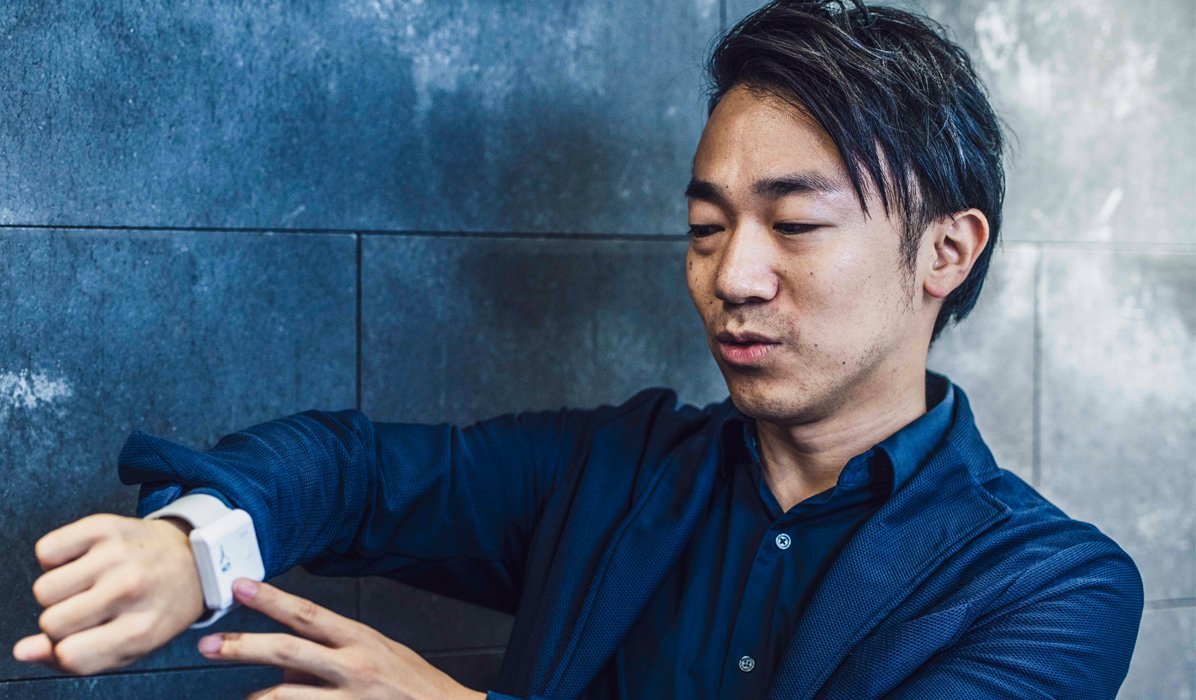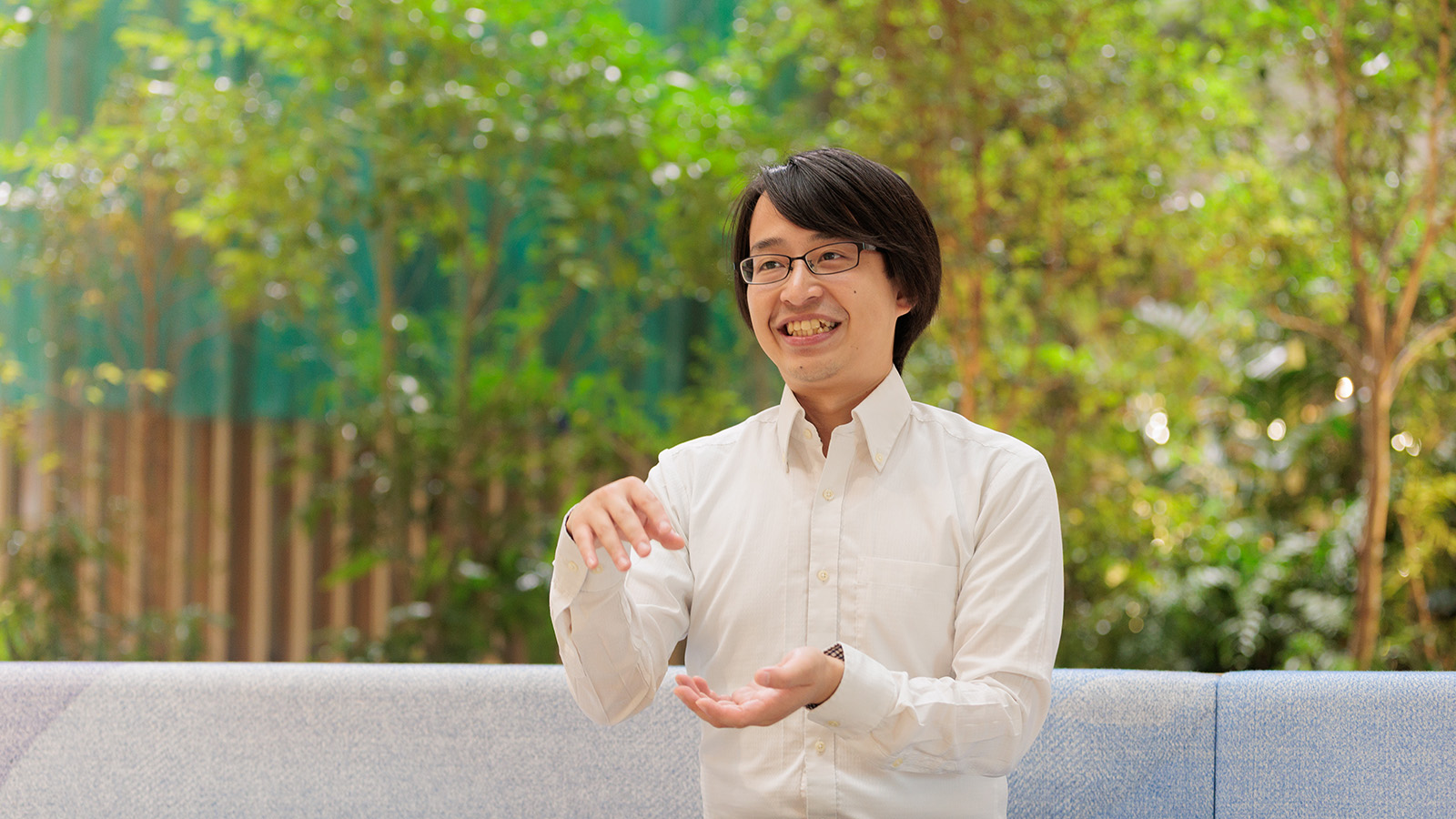
Panasonic's one-of-a-kind Human Body Communication System HiT provides a new type of communication, which facilitates communication among individuals simply by coming in contact with each other. When shaking hands, the device worn on one's wrist starts transmitting data, prompting communication by displaying on a tablet his/her information stored on a server, such as the profile and true thoughts that are difficult to express when meeting someone for the first time. This product was adopted by ZWEI, one of the largest matchmaking agency in Japan, and helped it achieve a high matching rate, double that of normal matchmaking events. The development team achieved substantial commercialization in less than half a year after the start of project planning through an open innovation with an external partner company.
Human Body Communication System HiT
Panasonic has been engaged in the research of human body communication for more than 15 years with the aim of achieving its business development. The company has long explored its use in the B2B business, but could not find optimal applications. During matchmaking events, participants should openly share their feelings; however, they often find that difficult. The matchmaking business is the very arena where Human Body Communication System HiT can be applied to offer the value of experience.
TALK 1: Fit for B2C Business
Increasingly Intuitive Device Tempts You to Try Human Body Communication
Members from left to right: Minoru Kumahara [Project planning], Mitsuru Tomita [Mechanical design], Kenta Tanaka [Software development], Naoyuki Shimizu [System development], and Masanori Minamiyama [Circuit design]. IoT Business Development Department, Business Development Center, Industrial Solutions Company.
Once launched, the potential project progressed at breakneck speed
How was the development of human body communication technology promoted?
Kumahara: This technology actually has quite a long history with its development launched in the early 2000s by then Matsushita Electric Works with the aim of utilizing the technology for the B2B business, such as housing and automotive products. This unique, hands-on communication method, which allows people to convey information by coming in contact with each other, has been a topic of conversation since back then. Meanwhile, we have had trouble with commercialization, such as to which situation we should apply this technology and how to monetize it.
Minamiyama: While there are several methods to conduct human body communication, Panasonic promoted communication via an electric field, in which data are communicated via the weak electric field generated around the human body. However, this method is susceptible to external factors and unsuitable for ensuring stable communication. I felt that it was hard to use this method for B2B applications, which require a stable communication performance under all environmental conditions.
Tomita: The circumstance changed around 2015. The product began to gain attention at various events due to its intuitive operability and well-received features, gradually shifting its arena from B2B to B2C. It became routine for Mr. Kumahara to come to my desk about every three months and casually ask me to draw up a body design by saying "Can you do it quickly?" (laugh) I gave 120% of my energy to meet the very strict requirements in a brutally short period of time.
The pain of repeating self-introductions has become a big issue in the matchmaking events; therefore, the department receives a number of inquiries for HiT, which transmits data simply by users coming in contact with each other.
The team initially made a prototype using metal parts; however, since it significantly affected communication characteristics, they eventually adopted resin material for all parts.
Tanaka: I am engaged in firmware development. Since I was assigned to this project immediately after I joined the company, I had no knowledge of other workplace environments and barely kept up with the speed of the project, where tasks were assigned one after another and the direction of the plan changed after each task. However, this experience definitely boosted my confidence.
Shimizu: For the first order, since it was an express request, I only had three days to complete a prototype. It was a challenging but a very intriguing experience at the same time since I came to this department wishing to create new businesses. Although I was in charge of another project, all project participants were flexible about sharing resources among projects. Everyone was engaged in respective projects with a sense of urgency to run the project cycle without delay.
Focus on the essence of technology and take on challenges in the new arena
How did you come to target pop idols' handshake events to achieve a proof of concept (PoC) prior to the product's application to matchmaking events?
Kumahara: It all started when we participated in CEATEC in 2016 to present human-to-human and human-to-object concepts. Subsequently, we established a track record through a wide range of initiatives, such as by participating in SXSW in Austin, Texas, conducting a survey of needs in Silicon Valley, demonstrating electric drills with an ID authentication function that works through easy and intuitive touch, and holding the Hug Battle hands-on event. Through these initiatives, we learned that human body communication technology can enhance the value of hands-on experience, and excels at quantifying human relationships. When we thought about fields where people-to-people interactions can constitute a business, we came to the world of entertainment business and then focused our attention on the pop idol industry, which has huge commercial potential with a growing market. We hypothesized that if our technology can facilitate interactions between idols and their fans, then such success will lead to new businesses. Then as soon as we got an opportunity, we made a prototype and carried out a PoC demonstration. That's our policy.
Minamiyama: In order to use the technology at handshake events, an easily attachable size was a required specification. The device was susceptible to performance degradation due to miniaturization in addition to already sensitive communication. Under these circumstances, the most difficult task was enhancing the communication performance, improving usability, and still achieving miniaturization while reviewing the design. Eventually, we succeeded in achieving a quarter of the initial size.
Kumahara: Blessed with a business partner who agreed to our business concept and a development team to fulfill our aspirations, we had no reason to miss an opportunity to conduct a product demonstration at the time. Since idols can instantly receive messages that each individual fan wishes to deliver, their response will inevitably change. If fans can hear what they want to hear from their idols, then they will become more devoted, which may naturally lead to an increase in CD and merchandise sales (laugh).
Minamiyama: In R&D, we often tend to focus on technological achievements; however, I believe that it is crucial to think about product usages from a user perspective and be conscious of technical applications.
Tomita: While technological applications were shifting to B2C, the significance of mechanical design also gradually changed. When the development of matchmaking devices was launched, a requirement was added to improve the product's look. In the B2B business, I had never paid attention to product design. For each task, I was encouraged to take on new challenges and learned a good lesson.
Kumahara: In the past, we only needed to focus on the improvement of product performance. Now, we are at the peak of design thinking. We must think of how users apply products to resolve their problems rather than the products themselves. We have learned that product design that facilitates people-to-people interactions is the very source of the value of human body communication technology. Although our participation in trade shows and other events was no easy task, it was an excellent opportunity to move onto the next step.
TALK 2: Key Points of the Service Business
Casual Handshakes to Start Truthful Communication. Learn More About People's Hearts
Members from left to right: Shota Miura [Mechanical design], Takuma Ishida [Circuit design], Tomonari Kuriaki [Core technology], and Masashi Takeda [Circuit design]. IoT Business Development Department, Business Development Center, Industrial Solutions Company.
Two people smiling at each other proves the value of HiT
How did you promote the development of HiT?
Kuriaki: Prior to the launch of the development process, all of us observed matchmaking events in person, which significantly altered our view of product development. While ensuring reliability was the biggest challenge in the B2B business, we were faced with completely different challenges in the B2C business. For instance, some women prefer wearing their watch loosely or over their clothes. The device worn in that way caused an interruption of data transmission during the PoC demonstration. Such situations were completely unexpected for this all-male development team (laugh).
Ishida: Obviously, a communication failure is a problematic phenomenon for a product; however, we can see it in a different light from the service provider perspective. HiT is activated by people coming in contact with each other. This physical contact provided a sense of ease, which unintentionally became a contributor to the high matching rate. Even when information was not displayed on the tablet as intended, the time spent on physical contact fostered a sense of ease, having more of a positive impact for the purpose of finding a partner. I was surprised to learn that even in the event of a malfunction, it will not have a negative impact depending on how the product is used.
A number of parts prepared for the "general rivet election." Project members insisted in unison that 3D printers are indispensable for rapid prototyping.
The team focused on a common issue during matchmaking events whereby participants look down at profile sheets instead of looking at each other. With the new system, the tablet display helps participant's eyes meet, which led to a higher matching rate.
Miura: At the outset of the development process, I could not quite understand the significance of a system where participants only shake hands and carry on conversations. However, after observing matchmaking events, I came to know the difficulty of maintaining a conversation with someone new.
Takeda: One will naturally acquire a user perspective after walking in their shoes. In addition to profile information, the tablet displays questions to facilitate communication, for which we got a lot of clues during actual events.
Kuriaki: I was delighted to witness participants, who were hesitant about shaking hands at the beginning of the event, gradually succeeding in communication with the help of HiT. The sense of contentment I felt when helping someone could never be achieved in a laboratory.
Pursuing functions sought after by users and higher service quality
Did you run into any obstacles during the commercialization process?
Kuriaki: Since I am responsible for improving communication characteristics, I focused on handshakes. The angle at which one puts out his/her hand and how one holds the other's hand vary by person. Some women only use fingertips when shaking hands. In addition to these subtle differences, I also examined the potential impact that the weather, environment, or gender difference may have on communication characteristics.
Ishida: Although antenna design, for which Mr. Takeda and I are responsible, is a rather challenging task, the part has no technical elements that differentiate it much from competitors' products. Therefore, if we wait until the technology matures, then competitors may take over our position. It is crucial to commercialize the technology as soon as possible, no matter how small it is. We must give top priority to establishing our brand ahead of others.
Miura: Just when I began to feel that the device was gradually achieving a satisfactory level of performance, I received a lukewarm response from the client. When I dug deeper, they told me that it was difficult to fasten the band of this wristwatch-type device. We can easily overlook these small details if it were not for client feedback.
Ishida: Human body communication technology is still under development. Therefore, we established a structure to compensate for inadequacies rather than trying too hard to meet every need during the manufacturing process of HiT. We outsourced the production of the device to an external EMS* company and its operation to our partner company so that we could focus on intellectual property and system development, as well as product adjustments with the client. Factories usually place utmost priority on production quality; therefore, I believe that HiT, which focuses on the functions and quality sought after by users, represents a rare case. We were able to release the product at this speed only because we shifted our focus to this direction.
* EMS stands for electronics manufacturing services and is a term used for companies that take on a package contract to manufacture electronic devices. The production of HiT is outsourced to a Japanese EMS.
Miura: Although the difficulty of fastening the watch band did not affect product performance, we discovered that it was attributable to rivets (protrusions) while working on a design change. We created more than 20 designs for the relevant part by changing the shape of the protrusion and standardizing the size of protrusions with an accuracy of 0.1 mm and then held a "general rivet election" within the team. It takes a week to create a prototype when outsourced to an external organization; however, if we do it on our own using a 3D printer, then it only takes half a day. The client later told us, "Actually, a sense of discomfort caused by rivets when the device was worn was the biggest obstacle for product introduction." I genuinely felt that we cannot create services acceptable to the world if we only discuss among ourselves.
Takeda: Users wished to engage in further conversation with their prospective partners and learn more about their values during matchmaking events. HiT shed light on the essence of human body communication, thereby creating added value. In order to make this product an essential part of matchmaking events, and furthermore, to disseminate human body communication technology into people's lives, we must continue to learn about end users.
TALK 3: First Step, Then Next Step
Make "Hits" to Achieve Home Run Innovations
Ryo Yamada
Project manager
IoT Business Development Department
Business Development Center, Industrial Solutions Company
I felt the genuine success of HiT when a female participant, who has been unsuccessfully attending matchmaking events for two years, finally found a good match. HiT communicated her personal interests on her behalf, which she had been hesitant to share, and she clicked with a male participant who understood her feelings. This event actually recorded a 100% matching rate; however, her finding a potential life partner encouraged me more in that this product will offer rays of hope to users who have difficulty opening up to others or wish to know others' real thoughts.
I joined Panasonic in April 2018 after working for a computer manufacturer and a software company. I had two missions, namely having an outlook on the commercialization of human body communication technology and establishing a success case of open innovations through horizontal specialization. My first attempt was to reduce research expenses. Expectations for sales decreased proportionally, which enabled us to create an environment to start the commercialization process on a small scale. At the same time, we entered into a business partnership with an external company and made an official decision as Panasonic to become a licenser. I am confident that this decision eventually enabled the team to focus on further developmental and technological enhancements.
Panasonic's level of technology is unquestionable. However, when it comes to the provision of service, its focus and points of view should be changed. Therefore, I promoted a variety of initiatives to enhance the team's mindset, such as by inviting an instructor specializing in lean startup from overseas. As a result, we succeeded in adding the value of customer experience to the conventional concept of creating products, that is, achieving the concept of creating experiences.
As the brand name "HiT" incorporates our thoughts, I believe that we can create home run innovations after producing a series of hits. The ideal state of human body communication technology is the world of the "E.T." movie, where we can understand each other through physical contact. I would like to search for the next "hits" in an attempt to gradually get closer to this ideal state.
# # #
- Disclaimer:
- We would like to note that Panasonic Newsroom is not a place to address personal Customer Service issues. Even though this is not the forum, Panasonic is always eager to resolve your concerns. Our local customer services contacts can be found at Global Support or you can see our list of Social Media Accounts to find the right channel for your queries and concerns.


